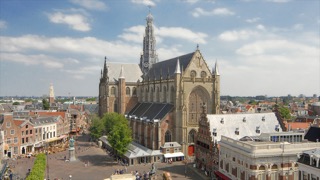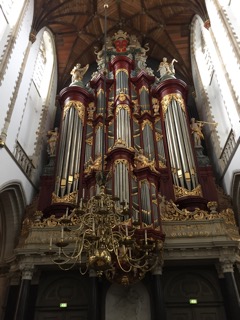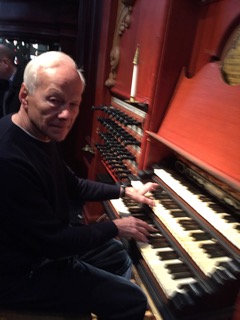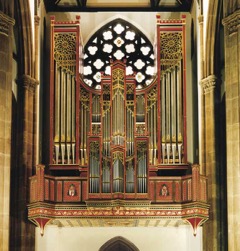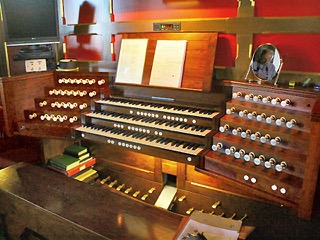Royal College Of Organists (RCO) visits to the Cathedrals of St Bavo, Haarlem, Netherlands and St Chad’s, Birmingham, United Kingdom
 I was privileged to take part in 2 superb visits organised by the Royal College of Organists in October. On the 13th, 14 slightly apprehensive amateur organists donned their L plates and headed across the Channel to the wonderful church and organ in Haarlem for an all-day class taken by the international recitalist, teacher and Bach expert Reitz Smits. The awe inspiring church dedicated to St Bavo has an organ to match, initially constructed by Christiaan Müller between 1736 and 1738. It was played by G.F. Händel in 1740 and 1750, who travelled to Haarlem especially for this purpose, and in 1766 the ten-year-old Mozart was also there.
I was privileged to take part in 2 superb visits organised by the Royal College of Organists in October. On the 13th, 14 slightly apprehensive amateur organists donned their L plates and headed across the Channel to the wonderful church and organ in Haarlem for an all-day class taken by the international recitalist, teacher and Bach expert Reitz Smits. The awe inspiring church dedicated to St Bavo has an organ to match, initially constructed by Christiaan Müller between 1736 and 1738. It was played by G.F. Händel in 1740 and 1750, who travelled to Haarlem especially for this purpose, and in 1766 the ten-year-old Mozart was also there.
Like most old organs, it has been extensively reconstructed through the ages, with much inappropriate pipework, voicing and other changes, especially in the 19th century. More recently, as former styles of organ building have become better known and more valued, determined attempts have been made to return the organ to as near an original state as possible.
The first restoration to take the organ nearer to its origins was undertaken by the Danish firm of Marcussen in 1959/60 – about 90% of the original pipes remained and new pipes, winding and actions were made in an authentic historic style. The organ is now in the care of the Dutch Company Flentrop who have continued with conservative revoicing to try and recapture the original sound. It is certainly a complete joy to listen to and to play; and the nervous students were soon enjoying themselves hugely playing one of the world’s most famous instruments.
On 29th October 6 of us, with 2 observers, travelled to St Chad’s RC Cathedral in Birmingham, which boasts a very fine 3 manual organ by J W Walker, built in 1990 with Nicolas Kynaston as consultant. The decision was taken that the only place where choir and organ could be together was in the west gallery, as originally intended by the Cathedral’s architect, Augustus Welby Pugin. The organ case and gallery were designed by David Graebe in late medieval style, with decoration by Gordon Foster.
The disposition of the organ within the case is very traditional: the Great occupies the centre of the main case with the Swell above and the Pedal department divided in towers on either side; the Positive is on the front of the gallery behind the player’s back, all controlled by mechanical action with electric stop action and a wide range of adjustable aids to registration.
The class was taken by Andrew Cantrill, organist of the Royal Hospital School Holbrook and a regular recitalist in the UK and abroad. Andrew’s subject was Performance and he came armed with a number of exercises to help a player achieve the best mental state for a fluent and satisfying concert. These included breathing, visualisation, musical preparation and mental awareness, all activities much practised by sportsmen and women to achieve optimum performance but not widely used by musicians so far. Andrew introduced the exercises one by one as he invited each of us to the console to play a prepared piece using the technique he had just explained and which we had practised away from the organ. A challenging and provocative afternoon which we all enjoyed, both for the academic content and the chance to play a very fine instrument.
The RCO arranges classes throughout the year and they can be found on the RCO website at https://www.rco.org.uk/education_college_events.php. There is a lot of other excellent information on the website too and you don’t have to be a member to access it although membership of the RCO is highly recommended, especially for the support the College provides for young members. Do check it out!
David Wakefield
| I was the President of the Organ Club of Great Britain from 2009 to 2012 and I am a Vice president of the Eric Thompson Trust, which provides bursaries for specific educational projects for young professional organists; and I chair the Larkin Trust with similar aims but associated with St. Giles Cripplegate and the Royal College of Organists, of which I became a Trustee and Council Member in 2013. I was elected to the committee of SSLSO at the 2016 AGM.My interest in all things “organ” has gone from being an occasional hobby to something of an unpaid profession, through which I have developed a range of contacts and informants. I will try and find relevant items from the world of organs, organists and organ music to entertain and inform you each month. |

